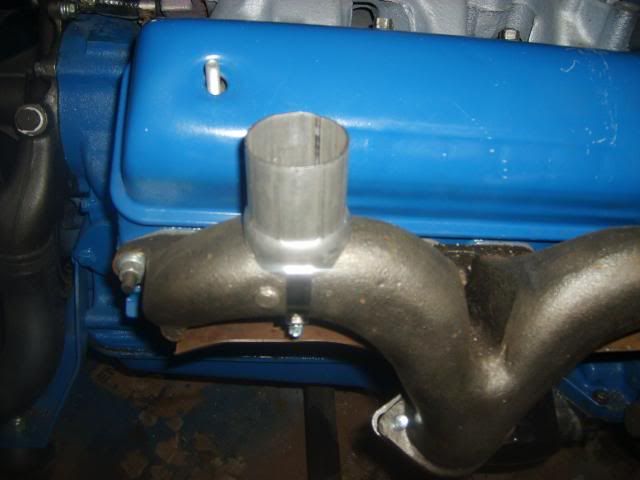|
Author
|
Message
|
|
vntgtrk
|
|
|
Group: Forum Members
Last Active: 11 Years Ago
Posts: 75,
Visits: 144
|
  This is my "broke after the holidays" project. I started with a body from an 80 something Ford and the snorkels are from who knows what. But they match and appear functional. I made up the ducts on the manifolds out of exhaust pipe reducers held on with hose clamps. Will I get better performance? As cool as this looks, I really don't care. And yes, I cut an xtra hole for the xtra snorkel
|
|
|
|
|
Ted
|
|
|
Group: Administrators
Last Active: Yesterday
Posts: 7.5K,
Visits: 205.8K
|
I’m assuming you have the vacuum operated valves within the snorkels so that the heated air from the exhaust manifolds can be cut off once the engine is warmed up? Those particular valves are typically hooked up to a vacuum sourced, coolant driven temperature sensor.
  Lorena, Texas (South of Waco) Lorena, Texas (South of Waco)
|
|
|
|
|
Talkwrench
|
|
|
Group: Forum Members
Last Active: 4 Years Ago
Posts: 898,
Visits: 23.2K
|
|
|
|
|
|
aussiebill
|
|
|
Group: Forum Members
Last Active: 5 Years Ago
Posts: 1.8K,
Visits: 11.4K
|
Ted (2/16/2014)
I’m assuming you have the vacuum operated valves within the snorkels so that the heated air from the exhaust manifolds can be cut off once the engine is warmed up? Those particular valves are typically hooked up to a vacuum sourced, coolant driven temperature sensor. My thought exactly.
 AussieBill YYYY Forever Y Block YYYY AussieBill YYYY Forever Y Block YYYY Down Under, Australia
|
|
|
|
|
vntgtrk
|
|
|
Group: Forum Members
Last Active: 11 Years Ago
Posts: 75,
Visits: 144
|
No I do not. These are the heat operated type. I plan on trying them first and if they don't close soon enough, the vacuum motors are easy enough to get. These snorkels are the perfect length though, so if I need to I may fit the vacuum motors and valve on these.
It's been my experience that these work as long as you keep 'em lubed.
|
|
|
|
|
junkyardjeff
|
|
|
Group: Forum Members
Last Active: Last Week
Posts: 813,
Visits: 3.4K
|
I put mid 80s mustang dual snorkel air cleaner on my 65 galaxie and used those pipe adapters to attach the hose to the shorty headers,I priced the hose kits and was shocked at the price so I made my own. I think the hose kits were about 40 dollars each and I had less then 15 dollars in what I made.
Butchering up everything I can get my hands on in Dayton Ohio
|
|
|
|
|
vntgtrk
|
|
|
Group: Forum Members
Last Active: 11 Years Ago
Posts: 75,
Visits: 144
|
I was reading my shop manual today and the crossover type exhaust has a heat riser valve that closes and allows exhaust gas to flow inside the intake manifold? I didn't know this. So a heat riser of some type will be needed in the winter here. And at least once a year we see semi humid weather with temps in the 34-38 degree range. That's carb ice weather.
|
|
|
|
|
charliemccraney
|
|
|
Group: Moderators
Last Active: Yesterday
Posts: 6.1K,
Visits: 443.0K
|
I wouldn't expect any icing problems without the heat riser at 34-38 degrees. If you have problems try a different carb spacer, thinner or a different material.
Lawrenceville, GA
|
|
|
|
|
vntgtrk
|
|
|
Group: Forum Members
Last Active: 11 Years Ago
Posts: 75,
Visits: 144
|
Carburetor icing starts at about 30 degrees F and can go up to about 40 or a bit more depending on dew point and humidity. Wanna hear horror stories about carb icing, talk to a private pilot. We don't experience it much on the ground but light plane recip guys experience it quite often comparatively speaking. I fought it when I had the 240 six and had the heat riser stuck shut
|
|
|
|
|
charliemccraney
|
|
|
Group: Moderators
Last Active: Yesterday
Posts: 6.1K,
Visits: 443.0K
|
I drive truck year round from temps in the teens to over 100. I have no heat riser and gaskets that restrict the passage in the intake. I do not experince icing. I have experienced it, though and a different carb spacer fixed it.
Lawrenceville, GA
|
|
|
|